
Mumbai is the capital city of the Indian state of Maharashtra. According to the United Nations, as of 2018, Mumbai is the second-most populous city in the country after Delhi and the seventh-most populous city in the world with a population of roughly 20 million. As per Indian government population census of 2011, Mumbai was the most populous city in India with an estimated city proper population of 12.5 million living under Municipal Corporation of Greater Mumbai. Mumbai is the centre of the Mumbai Metropolitan Region, the sixth most populous metropolitan area in the world with a population of over 23 million. Mumbai lies on the Konkan coast on the west coast of India and has a deep natural harbour. In 2008, Mumbai was named an alpha world city. It has the highest number of millionaires and billionaires among all cities in India. Mumbai is home to three UNESCO World Heritage Sites: the Elephanta Caves, Chhatrapati Shivaji Maharaj Terminus, and the city's distinctive ensemble of Victorian and Art Deco buildings.
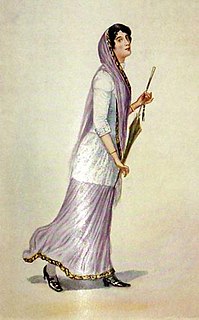
Parsis or Parsees, are an ethnoreligious group who migrated to the Indian subcontinent from Persia during the Muslim conquest of Persia of CE 636–651; one of two such groups. Zoroastrianism is the ethnic religion of the Parsi people. According to the Qissa-i Sanjan, Parsis migrated from the Sasanian Empire to Gujarat, where they were given refuge, between the 8th and 10th century CE to avoid persecution following the Muslim conquest of Persia.

The History of Mumbai, can be traced back to 600 BC, when evidences of the first known settlement,Harrappan Civilization, here have been discovered.

Sir Jamsetjee Jejeebhoy, 1st Baronet Jejeebhoy of Bombay, CMG, also spelt Jeejeebhoy or Jeejebhoy, was a Parsi-Indian merchant and philanthropist. He made a huge fortune in cotton and the opium trade with China. He was considered Bombay's most worthy son.

Kalbadevi is an old neighbourhood in Mumbai (Bombay), India. It is named after Goddess Kalbadevi, the Hindu Goddess. Kalbadevi area is one of the busiest areas during peak hours. The area has mostly traders in watches, bicycles, steel utensils, etc.
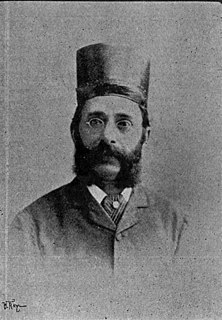
Sir Pherozeshah Merwanjee Mehta was an Indian Parsi politician and lawyer from Bombay. He was knighted by the British Government in India for his service to the law. He became the Municipal commissioner of Bombay Municipality in 1873 and its President four times – 1884, 1885, 1905 and 1911. Mehta was one of the founding member and President of the Indian National Congress in 1890.
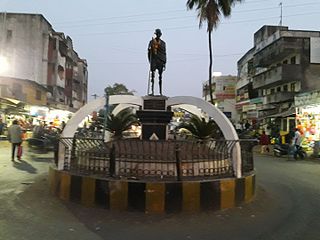
Navsari is a city, the ninth biggest municipality of Gujarat and the administrative headquarters Navsari District of Gujarat, India, located between Surat & Mumbai. Navsari is also the Twin City of Surat, and only 37 km south of Surat. In 2016, Navsari ranked as the 16th biggest city of Gujarat state of India by population in 2011. It used to rank 10th in 1991 to 2001. Navsari is the 25th "cleanest city of India" according to the Indian Ministry of Urban Development. Navsari is also a famous place due to the great Satyagraha march led by Mahatma Gandhi till the dandi.
Lovji Nusserwanjee Wadia (1702–1774) was a Parsi from Surat province of Gujarat in India and was a member of the Wadia family of shipwrights and naval architects, who founded Wadia Group in 1736.
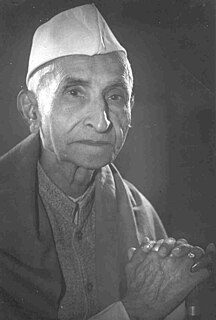
Ravishankar Raval (1892–1977) was a painter, art teacher, art critic, journalist and essayist from Gujarat, India. He worked for the magazine Vismi Sadi until it closed in 1921, and then founded the cultural magazine Kumar.
Human habitation of Mumbai existed since the Stone Age, the Kolis and Aagri were the earliest known settlers of the islands. The Maurya Empire gained control of the islands during the 3rd century BCE and transformed it into a centre of Buddhist culture and religion. Later, between the 2nd century BCE and 9th century CE, the islands came under the control of successive indigenous dynasties: Satavahanas, Abhiras, Vakatakas, Kalachuris, Konkan Mauryas, Chalukyas and Rashtrakutas, before being ruled by the Silharas from 810 to 1260.
Mumbai is the financial capital of India and one of the most populous cities in the world. Mumbai grew into a leading commercial center of India during the 19th century on the basis of textile mills and overseas trade. After independence, the desire to domesticate a Marathi social and linguistic Mumbai to a cosmopolitan framework was strongly expressed in the 1950s. Mumbai, one of the earliest cities in India to be industrialized, emerged as the centre of strong organized labour movement in India, which inspired labour movements across India.

Manockjee Cursetjee (1808–1887) was a Parsi businessman and judge from Bombay, remembered as a reformer and proponent of female education.
Parsi theatre is a generic term for an influential theatre tradition, staged by Parsis, and theatre companies largely-owned by the Parsi business community, which flourished between 1850 and 1930s. Plays were primarily in the Hindustani language, as well as Gujarati to an extent. After its beginning in Bombay, it soon developed into various travelling theatre companies, which toured across India, especially north and western India, popularizing proscenium-style theatre in regional languages.
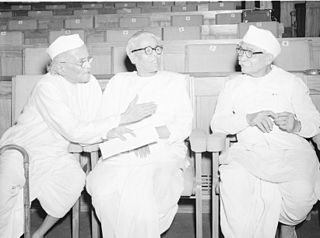
Jaishankar Bhudhardas Bhojak, better known by his theatre name Jaishankar Sundari , was an Indian actor and director of Gujarati theatre. Starting at the young age, he rose to fame for his roles of female impersonator in early Gujarati plays. He retired from acting in 1932 but returned to theatre direction and teaching in 1948. He directed and acted in several successful plays. He was awarded the Ranjitram Suvarna Chandrak in 1951 and the Padma Vibhushan in 1971.
The Media in Gujarati language started with publication of Bombay Samachar in 1822. Initially the newspapers published business news and they were owned by Parsi people based in Bombay. Later Gujarati newspapers started published from other parts of Gujarat. Several periodicals devoted to social reforms were published in the second half of the 19th century. After arrival of Mahatma Gandhi, the Indian independence movement peaked and it resulted in proliferation of Gujarati media. Following independence, the media was chiefly focused on political news. After bifurcation of Bombay state, the area of service changed. Later there was an increase in readership due to growth of literacy and the media houses expanded its readership by publishing more number of editions. Later these media houses ventured into digital media also. The radio and television media expanded after 1990.
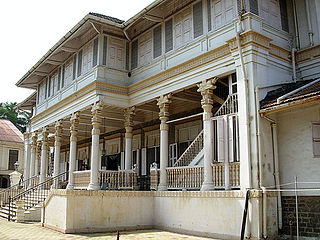
The Udvada Atash Behram, also known as the Iran Shah, "King of Iran", is a sacred fire housed in a temple in Udvada, Gujarat on the west coast of India. It is the first of the eight fire temples of the Zoroastrian religion in the country. The Atash Bahram, meaning "Victorious Fire", is the oldest fire temple in India, dated to the eighth century, and represents the historical cultural and religious links with Iran. The current temple housing the sacred fire was built in 1742 by Motlibai Wadia from Bombay. The temple structure, built spaciously, is well decorated and contains the Dasturji Koyaji Mirza hall and a museum. The main hall of the temple is accessed through a two-stage staircase. The temple attracts Zoroastrian pilgrims from all parts of India, Pakistan, and from around the world.
There was communal violence between Parsis and Bohra Muslims in May 1857 in Broach in India.

Mithuben Hormusji Petit was one of the women pioneer Indian independence activists who also participated in Mahatma Gandhi's Dandi March.
The Bombay Dog Riots, also known as the 1832 Bombay Riots, were a series of protest actions that devolved into rioting in the city of Mumbai, India. The riots were sparked by an attempt by the British government to exterminate the city's stray dogs, controversial for Parsis due to dogs being considered sacred in the Zoroastrian religion. The event was the first instance of rioting in the modern history of Mumbai.
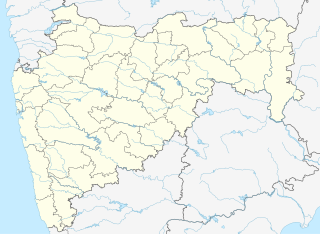
The Parsi–Muslim riots occurred in 1851 in Bombay, and were reprised in 1874 in parts of Gujarat. These marked the beginning of a period of tension in the two communities. The first riot took place over the blurred depiction of the Islamic prophet, Muhammad, and his appearance in a public print by a Parsi newspaper, Chitra Gyan Darpan, in October 1851. A second riot place on May 1857,over a Parsi named Bejonji Sheriaiji Bharucha was accused of disrespecting a mosque by some Muslims. A third riot took place on 13 February 1874, over an article on the life of Muhammad in a book entitled Famous Prophets and Communities.












